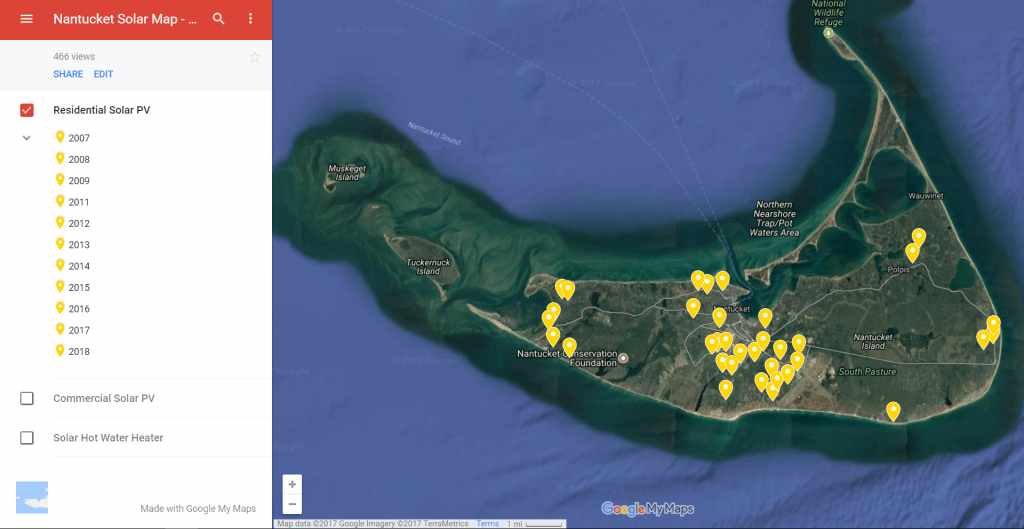Stimulating the Adoption of Solar PV on Nantucket
| Sponsor: | Town of Nantucket Energy Office |  |
| Sponsor Liaison: | Lauren Sinatra | |
| Student Team: | Zach Boyer, John Kirwan, Connor O’Neill, Nathan Pietrowicz | |
| Abstract: | Two undersea cables provide Nantucket with electricity, but a third cable may be needed in the future to accommodate peak summer demands. To avoid this eventuality Nantucket is exploring a variety of options, including the adoption of renewable energies in conjunction with energy storage systems to enhance energy independence. The goal of our project was to assist the Nantucket Energy Office in promoting the adoption of photovoltaics on Nantucket. We conducted research, interviewed stakeholders, and distributed a survey to local residents to identify the current barriers to solar PV on Nantucket. We developed web-based promotional materials, including an interactive map, solar PV owner profiles, and a comprehensive list of FAQs, and recommended improvements to the permitting process. | |
| Link: |
Final Report: Nantucket Energy Office Final Report Final presentation: Nantucket Energy Office Team Presentation Webpage: Nantucket Solar Map & Resources |
|
Executive Summary
The demand for electricity on Nantucket has been growing at more than five times the Massachusetts state average and current electricity prices on Nantucket are significantly higher, at 21.5 cents/kWh, than the national average of 13.19 cents/kWh. (Regular Residential Rates, 2017; Basic Service Rates, 2017; Electric Power Monthly, August 2017). The Town of Nantucket Energy Office has been engaged in a variety of activities to reduce electricity consumption and costs for Nantucket residents.
These activities start with educating the public on how to be energy efficient as well as how to conserve energy. The Town of Nantucket Energy Office is also in the process of applying for the MassCEC’s HeatSmart Program, increasing clean heating and cooling installations, which will help lower resident’s cost of electricity. Education programs and incentives like net metering, income tax credits, Massachusetts Solar Renewable Energy Certificates (SREC-II), tax exemptions and the Mass Save program, along with other small efforts, are great ways to save money and make residents aware of the energy problem. The Town of Nantucket Energy Office is hoping to promote greater use of residential solar PV on the island with its recently launched SOLAR Rebate Program for residents. This offers rebates up to a maximum of $2,500, as a way to reduce the initial cost of a solar PV system (Sinatra, 2017). Additionally, the Town of Nantucket Energy Office’s newly approved grant will soon add more than 200 of Tesla’s Powerpacks. These will give Nantucket a 48 MWh battery system, hopefully reducing the long-term price of electricity as well as the lowering the possibility of brownouts in the summer months. Promoting the adoption of solar PV should impact the current problem Nantucket is facing in a positive way. Our project aims to stimulate the interest and adoption of residential solar photovoltaic energy on the island.
The goal of our project was to provide recommendations to the Town of Nantucket Energy Office (NEO) on ways to stimulate the adoption of solar PV systems on Nantucket. To accomplish this, we established the following objectives:
1. Identify opportunities for and barriers against the adoption of solar PV.
We created and distributed a survey aimed at gauging public awareness of solar PV on the island. We also conducted one-on-one interviews with current owners, representatives of the Historic District Commission (HDC), and on-island and off-island solar PV installers.
2. Determine the current installed capacity of solar PV.
We consolidated information from several databases including the Massachusetts Department of Revenue SREC-II database, the Massachusetts Clean Energy Center database, HDC permitting and inspection files, building permits and Nantucket’s Geographic Information System, GIS, in addition to Google Maps.
3. Develop new approaches to promote the adoption of solar PV.
We developed an interactive map depicting each residential and commercial installation as well as specific information for each system. We also wrote three in-depth profiles on three solar PV owners to spread awareness on the process of installing solar PV and their experiences with owning a solar PV system. Lastly, we created a webpage that displays all of the above information as well as Frequently Asked Questions regarding solar PV and a flowchart describing the town permitting processes specific to solar PV.
Stakeholder Opinions on PV Permitting and Installation
Historic District Commission Perspectives
- The HDC does not want solar PV installations installed in the Historic Cores if they are visible from the street.
- The HDC will allow solar PV to be installed outside the Historic Cores with more leniency than inside the Cores.
- HDC members are aware of the energy problems the island is facing.
- The HDC may allow Tesla roof tiles inside the Historic Cores when they become available to the consumer market.
Homeowners Perspective
- The HDC was not perceived to be an impediment to the installation of solar PV systems with any of the homeowners we interviewed.
- The homeowners payed little or nothing for electricity after the installation of their solar PV systems.
- Most if not all homeowners installed their PV systems for environmental concerns rather than financial reasons.
Installer Perspectives
The interviews with on-island and off-island installers shed light on the specifics of the permitting process. When interviewing the one on-island installer, ACK Smart, we found that many interested owners look at them first, as they want to go with someone local. The on-island installer also has a lot of experience and knowledge of the solar PV application process. Interviewing the two primary off-island installers, Cotuit Solar and SunWind LLC, revealed the difficulties installing solar PV systems on an island thirty miles off the cape. It also showed us that although the owners we interviewed did not have any significant problems with their HDC applications, the installers had instances where their projects required multiple revisions, often delaying the job by a few months. For off-island installers this is very costly, as it means that they have to make more trips back to the island to submit another revision to the HDC. In addition to this, off-island installers have the costs that come with bringing their team to and from the island as well as housing them on-island. Shipping the materials required to build and install a solar PV system also adds to this costs. To accommodate these expenses, it can cost off-island companies $3,500 to $5,000 extra to install solar PV systems on Nantucket. In terms of cost differences between on-island and off-island installers, we learned that although off-island installers have the costs of bringing everything here, on-island installers have to account for the costs of living on island.
Installed PV Capacity on Nantucket
After consolidating information, there are forty installed solar PV systems on Nantucket. Thirty of these systems are residential, with the ten other systems being commercial systems, two of which account for the majority of on-island solar PV generation. In addition to this, there are five residential systems which are still in the process of being built and should be completed by the end of 2017 or early 2018. The number of installed systems has been increasing rapidly over the past few years, as shown in Figure A, with nine residential systems having been installed this year alone. Bartlett Farms, a commercial system generating over .5MW, is also looking to triple its size, which will add a significant amount to Nantucket’s installed PV capacity.
Figure A: Residential Installed Systems on Nantucket Since 2007
Public Attitudes and Awareness about PV
Our survey revealed residents awareness and knowledge of solar PV in addition to any of their perceived opinions and misconceptions. Our survey findings conclude:
- There needs to be better and more easily available information to inform the public on the topic of solar PV.
- Much can be done to increase Nantucket resident’s awareness on solar PV, which our project deliverables aim to target.
- When considering installing solar PV, the top three primary concerns were with local permitting, finding a trustworthy installer, and the initial upfront cost.
- When considering installing solar PV, the top three primary benefits were battery storage and backup power, innovative technology, and saving money and reducing electric bills.
Project Deliverables
Based on our research and findings, we developed a set of deliverables to aim the Town of Nantucket Energy Office promoting the adoption of PV on Nantucket. These deliverables include:
- An interactive online map (as seen in Figure B) that shows the location and specifications of residential and commercial solar PV and solar hot water systems.
- Three owner profiles showcasing each owner’s motivations, the installation and application process, and the basic system specifications.
- A flow chart outlining the permitting process for a residential PV system installation.
- A webpage on the Nantucket Town website that displays all of the deliverables.
Figure B: Interactive Solar PV Map
Findings and conclusions
The permitting process for the installation of PV on Nantucket presents difficulties for some homeowners and installers. Accordingly, we recommend that:
- The Nantucket Historic District Commission revise its application form to include renewable energies, such as solar PV, either through the inclusion of a few checkboxes regarding renewable energies or by providing more in-depth instructions on the process to apply for an HDC permit regarding renewable energy.
- The HDC reconsider and clarify their position on where solar PV can be installed outside of the Historic Cores.
- The Historic District Commission develop a clear set of guidelines for homeowners and installers regarding the installation of PV systems within and outside the historic districts of Nantucket.
The Town of Nantucket Energy Office should continue to promote the adoption of solar PV on the island. To enhance the likely success of these efforts we recommend that the Nantucket Energy Office:
- Take the lead in establishing better communication with the Historic District Commission to gather data on solar PV installations.
- Use the tools we developed to continue to promote and educate residents on solar PV.
- Update the owner database and interactive map with new solar PV installations using the directions given in Appendix F.
With continued promotion of the local rebate program and using the tools we have provided on the Town of Nantucket Energy Office’s website, we anticipate that the number of installed systems on island will continue to grow rapidly over the next several years.




